Flood
Flood relatively high flow of water that overtops the natural or artificial banks in any of the reaches of a stream. When banks are overtopped, water spreads over the floodplain and generally causes problems for inhabitants, crops and vegetation. Since floodplain is a desirable location for man and his activities, it is important to control floods so that the damage does not exceed an acceptable level.
Floods are more or less a recurring phenomenon in Bangladesh and often have been within tolerable limits. But occasionally they become devastating. Each year in Bangladesh about 26,000 sq km, 18% of the country is flooded. During severe floods, the affected area may exceed 55% of the total area of the country. In an average year, 844,000 million cubic metre of water flows into the country during the humid period (May to October) through the three main rivers the ganges, the Brahmaputra-Jamuna and the meghna. This volume is 95% of the total annual inflow. By comparison only about 187,000 million cu m of streamflow is generated by rainfall inside the country during the same period.
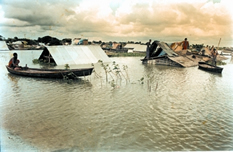
In Bangladesh, the definition of flood appears differently. During the rainy season when the water flow exceeds the holding capacity of rivers, canals (khals), beels, haors, low-lying areas it inundates the whole area causing damage to crops, homesteads, roads and other properties. In the Bangladesh context there is a relation between inundation and cropping.
Floods in Bangladesh can be divided into three categories: (a) monsoon flood - seasonal, increases slowly and decreases slowly, inundates vast areas and causes huge losses to life and property; (b) flash flood - water increases and decreases suddenly, generally happens in the valleys of the hilly areas; and (c) tidal flood - short duration, height is generally 3m to 6m, blocks inland flood drainage.
The combined annual flood wave from the Ganges, brahmaputra and Meghna rivers passes through a single outlet, the lower meghna tide levels in the bay of bengal, reducing the slope and discharge capacity of the Lower Meghna. The effects of these high river water levels extend over most of the country and are the main determinant of the drainage condition and capacity. The discharge from minor rivers is reduced and surface drainage by gravity is limited to land above the prevailing flood level. Flooding caused by this drainage congestion exists nearly everywhere except in the highland and hilly areas in the northern and eastern parts of the country.
In the northwest region an embankment protects the right floodplains of the tista and the Brahmaputra. In the north there are large areas of shallow flooding interspersed with more deeply flooded pockets in meander scars and old flood basins.

In the south a highland area separates the Ganges from the deep flood basin in chalan beel. Nearly all the monsoon drainage of the northwest region east of the atrai river and south of the Tista river passes through this flood basin to the Brahmaputra. In the northeast region floodplains can be divided into three distinct areas - the Brahmaputra and Padma left floodplain; the old brahmaputra river valley separated from the Brahmaputra by the madhupur tract; and the Meghna river basin.
The Meghna basin is dominated by the great Sylhet depression where the surma and kushiyara rivers join to form the Meghna. High water levels in Meghna are controlled downstream by the water levels of the padma during the flood season. It fills rapidly with floodwater early in the monsoon and remains full until the Lower Meghna falls in the post-monsoon period. Drainage rates of this basin are low.
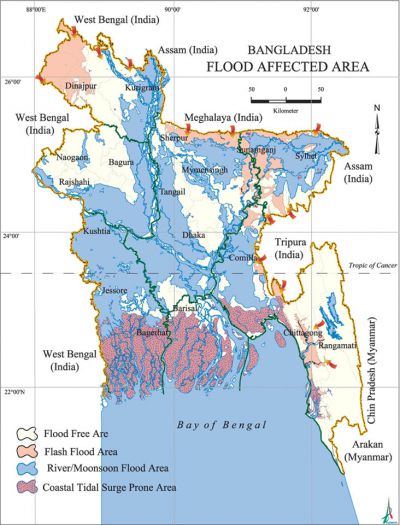
Hill catchment draining into the northeast and southeast regions is characterised by flash floods that are mostly of short duration but unpredictable in frequency and intensity. Several floods may occur in the flashy rivers in any water year. Throughout most of the south-central and southwest regions, flooding is mainly associated with tidal influences, storm surges and poor drainage. The northern half of the south-central region is the principal floodplain of the Padma and Lower Meghna, while the southern half is the main network of estuary channels which distribute about 40% of the Lower Meghna flow to the sea.
The drainage system of the southwest region consists mainly of silted former distributaries of the Ganges connected to the sea by a largely Moribund Delta. Consequently there is extensive shallow flooding.
The factors for causing floods in Bangladesh are: (a) general low topography of the country with major rivers draining through Bangladesh including a congested river network system, (b) rainfall in the upstream country or in the mainland, (c) snow-melt in the himalayas and glacial displacement (natural), (d) river siltation/lateral river contraction/landslides, (e) synchronisation of major river peaks and influences of one river on the other, (f) human intervention of the environment, (g) tidal and wind effects on slowing down the river outflow (backwater effect), (h) construction of barrages and protective works along the banks of the river - some are very close to both the banks - in the upper reaches thus making the passage of water flow downstream increasingly narrower and resulting in greater acceleration of water flow downstream presently than before. (i) deforestation in the upper reaches of the rivers is not only leading acceleration of water flow downstream but also lead deposition of loads in the river beds, resulting in reduced channel flow and consequent overland runoff water and (j) tectonic anomalies (earthquake) those change in river flow/morphology.
History of floods in this country is perhaps inseparable from the history of this land. In every century, the bengal delta witnessed the visit of nearly half a dozen floods, almost equal to the magnitude and intensity of those in 1987, 1988 and 1998 and as many with lesser magnitude.
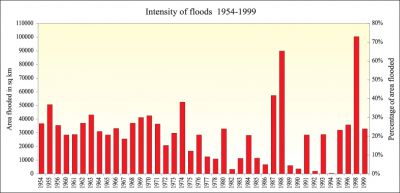
The monsoon phenomenon has been mentioned in the holy ramayana and mahabharata [Mahabharata] and other Vedic books. In the book Artha-Shastra [Artha-Shastra] written during the reign of Chandragupta Maurya (321-296 BC) by his minister Kautilaya, there is mention of the amount of rain at different places indicating that they had knowledge of rainfall measurements. The astronomer barahmihir' [Barahamihira] (505-587 AD) used to predict rain. Astronomers Arya Bhatta and Brahmagupta also studied the monsoon. kalidasa, the famous sanskrit poet composed poems on monsoon clouds in his Meghdut and Ritusamahara. However, during the ancient times a lady named Khona' [Khana] made most of the predictions on meteorology and agrometeorology. Even to this day the farmers of Bangladesh remember her verses. The Arabs used the knowledge of the changing pattern of monsoon winds very profitably for trade with India. The term 'monsoon' is derived from the Arabic word 'Mausam' meaning season. The first comprehensive report of Professor pc mahalanabish on floods in Bengal between 1870 and 1922 shows that moderate floods have occurred once in two years on an average, while severe floods have occurred once in 6-7 years on an average.
 |
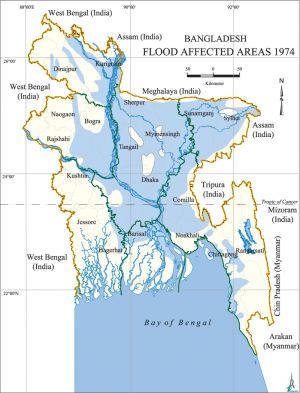 |
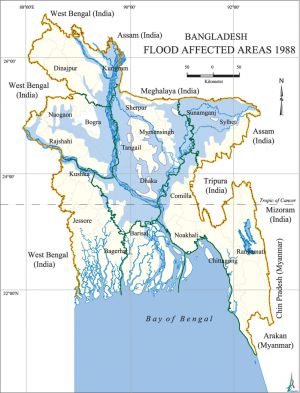 |
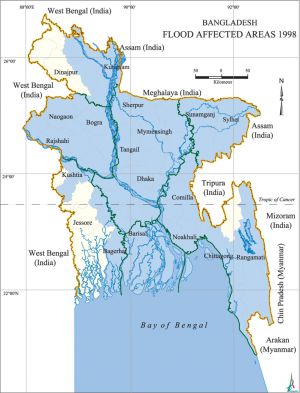 |
Flooding in Bangladesh is a recurring phenomenon. Recurrent floods between 1787 and 1830 changed the old course of the Brahmaputra. After a major flood in northern Bengal in 1922, a Flood Committee was formed and a report was published in 1927 on the north Bengal floods between 1870 and 1922. Statistical analysis of available records revealed that severe floods can occur every 7 years, and catastrophic floods every 33-50 years. Some severe monsoon floods of this region starting from the late 18th century are described here chronologically:
Chronology of big floods
1781 Serious flood, which was more pronounced in the western part of sylhet district. The cattle suffered much from the loss of fodder.
1786 Floods in the Meghna wrought havoc to the crops and immense destruction of the villages on the banks. It was followed by a famine, which caused great loss of life at bakerganj. At Tippera the embankment along the gumti gave way. At Sylhet the parganas were entirely under water, the greater part of the cattle drowned and those surviving were kept on bamboo rafts.
1794 The Gumti embankment burst again, causing much damage around Tippera.
1822 Bakerganj division and Patuakhali subdivision were seriously affected, 39,940 people died and 19,000 cattle perished and properties worth more than 130 million taka were destroyed. barisal, Bhola and manpura were severely affected.
1825 Destructive floods occurred at Bakerganj and adjoining regions. There were no important embankments or other protective works against inundation in the district.
1838 Heavy rainfall caused extensive inundation at rajshahi and a number of other districts. The cattle suffered much from loss of fodder and the people were greatly inconvenienced when driven to seek shelter on high places and when the water subsided cholera broke out in an epidemic form.
1853 Annual inundation was more pronounced than usual in the west of Sylhet district, partly the result of very heavy local rainfall and partly caused by the overflow of the Meghna.
1864 Serious inundation when the embankment was breached and the water of the Ganges flooded the greater part of Rajshahi town. There was much suffering among the people who took shelter with their cattle on the embankment.
1865 Extensive inundation caused by the annual rising of the Ganges flooded Rajshahi district. Excessive rainfall seriously affected Rajshahi town.
1867 Destructive flood also affected Bakerganj. Crop was partially destroyed. But no general distress resulted.
1871 Extensive inundation in Rajshahi and a few other districts. Crops, cattle and valuable properties were damaged. This was the highest flood on record in the district. Cholera broke out in an epidemic form.
1876 Barisal and patuakhali were severely affected. Meghna overflowed by about 6.71m from the sea level. Galachipa and Bauphal were damaged seriously. A total of about 215,000 people died. Cholera broke out immediately after flood.
1879 Flooding of the Tista when the change in the course of the Brahmaputra began.
1885 Serious floods occurred due to the bursting of an embankment along the Bhagirathi, affected areas of Satkhira subdivision of khulna district.
1890 Serious flood at satkhira caused enormous damage to cattle and people.
1900 Due to the bursting of an embankment along the Bhagirathi, Satkhira was affected.
1902 At Sylhet the general level of the river went so high that there was terrible flood. Crops and valuable properties were damaged.
1904 The crops in some parts of cox’s bazar subdivision and kutubdia island were damaged due to an abnormally high tide. This flood was exceptional in severity in mymensingh. The distress caused on this occasion is probably the nearest parallel to that which resulted from the flooding of the Tista in 1879, when the change in the course of Brahmaputra began.
1954 On August 2, Dhaka district went under water. On August 1 flood peak of the jamuna river at Sirajganj was 14.22m and on August 30 flood peak of the Ganges river at hardinge bridge was 14.91m.
1955 More than 30% of Dhaka district was flooded. The flood level of the buriganga exceeded the highest level of 1954.
1962 The flood occurred twice, once in July and again in August and September. Many people were affected and crops and valuable properties were damaged.
1966 One of the most serious floods that ever visited Dhaka occurred on 8 June 1966. The flood level was almost the highest in the history of Sylhet district too. A storm on the morning of 12 June 1966 made the situation grave. About 25% of houses were badly damaged, 39 people died and 10,000 cattle were lost, and about 1,200,000 people were affected. On September 15 Dhaka city became stagnant due to continuous rainfall for 52 hours, which resulted in pools of water 1.83m deep for about 12 hours.
1968 Severe flood in Sylhet district and about 700,000 people were badly affected.
1969 Chittagong district fell in the grip of flood caused by heavy rainfall. Crops and valuable property were damaged
1974 In Mymensingh about 10,360 sq km area was flooded. People and cattle were severely affected and more than 100,000 houses were destroyed.
1987 Catastrophic flood occurred in July-August. Affected 57,300 sq km (about 40% of the total area of the country) and estimated to be a once in 30-70 year event. Excessive rainfall both inside and outside of the country was the main cause of the flood. The seriously affected regions were on the western side of the Brahmaputra, the area below the confluence of the Ganges and the Brahmaputra, considerable areas north of Khulna and finally some areas adjacent to the Meghalaya hills.
1988 Catastrophic flood occurred in August-September. Inundated about 82,000 sq km (about 60% of the area) and its return period is estimated to be 50-100 years. Rainfall together with synchronisation of very high flows of all the three major rivers of the country in only three days aggravated the flood. Dhaka, the capital of Bangladesh, was severely affected. The flood lasted 15 to 20 days.
1989 Flooded Sylhet, sirajganj and maulvi bazar and 600,000 people were trapped by water.
1993 Severe rains all over the country, thousands of hectares of crops went under water. Twenty-eight districts were flooded.
1998 Over two-thirds of the total area of the country was flooded. It compares with the catastrophic flood of 1988 so far as the extent of flooding is concerned. A combination of heavy rainfall within and outside the country, synchronisation of peak flows of the major rivers and a very strong backwater effect coalesced into a mix that resulted in the worst flood in recorded history. The flood lasted for more than two months.
2000 Five southwestern districts of Bangladesh bordering India were devastated by flood rendering nearly 3 million people homeless. The flood was caused due to the outcome of the failure of small river dykes in West Bengal that were overtopped by excessive water collected through heavy downpour.
Flood management Flood control and drainage projects heavily depended on dredging, embankments, polder and gravity drainage. Heavy dependence on structural means to manage floods, together with the effects of such other structures as roads, highways and railroads that obstruct flow of water in some cases aggravate the flood situation. Despite huge amounts of investment in flood control and drainage projects, the benefits have been less than satisfactory.
The floods of 1987, 1988 and 1998 were catastrophic, leading to widespread destruction, misery and loss of life. The severity of the floods of 1987 and 1988 led the government to look for a plan, which would in the long term provide a comprehensive and permanent solution to the recurrent flood problem. Several major studies were taken up in 1989. These studies led to formulation of the flood action plan (FAP) in 1989.
To reduce the losses from floods as well as to use the surplus water for irrigation, the bangladesh water development board, as part of structural measures for flood control, constructed a number of embankments and barrages and dug canals. Some major projects are: ganges-kobadak irrigation project (G-K Project), Dhaka-Narayanganj-Demra (DND) Project, Karnafuli Multipurpose Project, Coastal Embankment Project, Tubewell Project in northern Bangladesh, Brahmaputra Right Embankment Project, Chandpur Irrigation Project, Meghna-Dhonagoda Project, Manu River Project, Khowai River Project, Pabna Irrigation Project, Gumti Project, Muhuri Irrigation Project, Tista Barrage Project (Phase-I), Dhaka Integrated Flood Protection Project, System Rehabilitation Project, Early Implementation Project.
However, an alternative strategy for mitigating flood hazard, the concept of social adjustment, also known as non-structural measures can be important. These include: (a) Dissemination of meteorological forecasts, short and long range warning system including the height to which the flood water is likely to rise in the next few hours or so and a programme of speedy evacuation. (b) Land management for reduction of runoff water. In this case a programme of afforestation and reforestation together with animal grazing controls to increase absorption and reduction of runoff water could be undertaken. (c) landuse change and enactment of building codes, diversification of agricultural production, that is, identification and planting of flood resistant crops and adjustment of planting season. (d) Floodplain zoning, involving landuse zoning to control development and restrictive development regulations, should ensure that any development meets certain standards and that they take into consideration the threat to a site.
Non-structural measures can be implemented at nominal costs and in a very short time resulting in positive benefit to the floodplain users.
Since flood management is an integral part of overall water resource management, regional cooperation in this area will help create a better climate for the much-needed joint strategies for sustainable utilisation of the water ecosystem. [Sifatul Quader Chowdhury and Md Sazzad Hossain]
Bibliography M Aminul Islam, Environment Land Use and Natural Hazards in Bangladesh, University of Dhaka, 1995; Qazi Kholiquzzaman et al ed, Perspectives on Flood, University Press Limited, Dhaka, 1998; Thomas Hofer, Floods in Bangladesh: A Highland-Lowland Interaction, Geographica Bernensia, University of Berne, Switzerland, 1998; Bangladesh Water Development Board (BWDB), Annual Flood Report 1998, Flood Forecasting and Warning Centre, BWDB, 1999.
